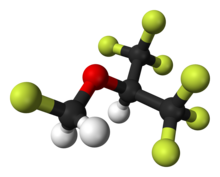Sevoflurane,sold under the brand nameSevorane,among others, is a sweet-smelling, nonflammable,highly fluorinated methyl isopropyl etherused as aninhalational anaestheticfor induction and maintenance ofgeneral anesthesia.Afterdesflurane,it is the volatile anesthetic with the fastest onset.[8]While its offset may be faster than agents other than desflurane in a few circumstances, its offset is more often similar to that of the much older agentisoflurane.While sevoflurane is only half as soluble as isoflurane in blood, the tissue blood partition coefficients of isoflurane and sevoflurane are quite similar. For example, in the muscle group: isoflurane 2.62 vs. sevoflurane 2.57. In the fat group: isoflurane 52 vs. sevoflurane 50. As a result, the longer the case, the more similar will be the emergence times for sevoflurane and isoflurane.[9][10][11]
 | |
 | |
| Clinical data | |
|---|---|
| Trade names | Ultane, others |
| AHFS/Drugs.com | Micromedex Detailed Consumer Information |
| Pregnancy category |
|
| Routes of administration | Inhalation |
| Drug class | Anesthetic |
| ATC code | |
| Legal status | |
| Legal status | |
| Pharmacokineticdata | |
| Metabolism | LiverbyCYP2E1 |
| Metabolites | Hexafluoroisopropanol |
| Eliminationhalf-life | 15–23 hours |
| Excretion | Kidney |
| Identifiers | |
| |
| CAS Number | |
| PubChemCID | |
| IUPHAR/BPS | |
| DrugBank | |
| ChemSpider | |
| UNII | |
| KEGG | |
| ChEBI | |
| ChEMBL | |
| CompTox Dashboard(EPA) | |
| ECHA InfoCard | 100.171.146 |
| Chemical and physical data | |
| Formula | C4H3F7O |
| Molar mass | 200.056g·mol−1 |
| 3D model (JSmol) | |
| Density | 1.53 g/cm3 |
| Boiling point | 58.5 °C (137.3 °F) |
| |
| |
It is on theWorld Health Organization's List of Essential Medicines.[12]
Medical uses
editIt is one of the most commonly usedvolatileanesthetic agents, particularly for outpatient anesthesia,[13]across all ages, but particularly in pediatric anesthesia, as well as in veterinary medicine. Together withdesflurane,sevoflurane is replacingisofluraneandhalothanein modern anesthesia practice. It is often administered in a mixture ofnitrous oxideand oxygen.
Physiological effects
editSevoflurane is a potentvasodilator,as such it induces a dose dependent reduction in blood pressure and cardiac output. It is abronchodilator,however, in patients with pre-existing lung pathology, it may precipitate coughing andlaryngospasm.It reduces the ventilatory response tohypoxiaandhypercapnia,and impedes hypoxic pulmonary vasoconstriction. Sevoflurane vasodilatory properties also cause it to increase intracranial pressure and cerebral blood flow. However, it reduces cerebral metabolic rate.[14][15]
Adverse effects
editSevoflurane has an excellent safety record,[13]but is under review for potentialhepatotoxicity,and may accelerate Alzheimer's.[16]There were rare reports involving adults with symptoms similar tohalothanehepatotoxicity.[13]Sevoflurane is the preferred agent for mask induction due to its lesser irritation tomucous membranes.
Sevoflurane is an inhaled anesthetic that is often used to induce and maintain anesthesia in children for surgery.[17]During the process of awakening from the medication, it has been associated with a high incidence (>30%) of agitation anddeliriumin preschool children undergoing minor noninvasive surgery.[17]It is not clear if this can be prevented.[17]
Studies examining a current significant health concern, anesthetic-induced neurotoxicity (including with sevoflurane, and especially with children and infants) are "fraught with confounders, and many are underpowered statistically", and so are argued to need "further data... to either support or refute the potential connection".[18]
Concern regarding the safety of anaesthesia is especially acute with regard to children and infants, where preclinical evidence from relevant animal models suggest that common clinically important agents, including sevoflurane, may be neurotoxic to the developing brain, and so cause neurobehavioural abnormalities in the long term; two large-scale clinical studies (PANDA and GAS) were ongoing as of 2010, in hope of supplying "significant [further] information" on neurodevelopmental effects of general anaesthesia in infants and young children, including where sevoflurane is used.[19]
In 2021, researchers at Massachusetts General Hospital published in Communications Biology research that sevoflurane may accelerate existing Alzheimer's or existing tau protein to spread: "These data demonstrate anesthesia-associated tau spreading and its consequences. [...] This tau spreading could be prevented by inhibitors of tau phosphorylation or extracellular vesicle generation." According to Neuroscience News, "Their previous work showed that sevoflurane can cause a change (specifically, phosphorylation, or the addition of phosphate) to tau that leads to cognitive impairment in mice. Other researchers have also found that sevoflurane and certain other anesthetics may affect cognitive function."[16]
Additionally, there has been some investigation into potential correlation of sevoflurane use and renal damage (nephrotoxicity).[20]However, this should be subject to further investigation, as a recent study shows no correlation between sevoflurane use and renal damage as compared to other control anesthetic agents.[21]There is also evidence that renal damage may be caused by compound A, a product of the degredation of sevoflurane.[22]
Pharmacology
editThe exact mechanism of the action of general anaestheticshas not been delineated.[23]Sevoflurane acts as apositive allosteric modulatorof theGABAAreceptorinelectrophysiologystudies of neurons and recombinant receptors.[24][25][26][27]However, it also acts as anNMDA receptor antagonist,[28]potentiatesglycine receptorcurrents,[27]and inhibitsnAChR[29]and5-HT3receptorcurrents.[30][31][32]
History
editSevoflurane was discovered by Ross Terrell alongside Louise Speers.[33]Sevoflurane was concurrently synthesized by Richard Wallen.[33]The rights for sevoflurane worldwide were held byAbbVie.It is available as ageneric drug.
Global-warming potential
editSevoflurane is agreenhouse gas.The twenty-yearglobal-warming potential,GWP(20), for sevoflurane is 349, however this is significantly lower than isoflurane or desflurane.[34]
Degradation
editSevoflurane will degrade into what is most commonly referred to as compound A (fluoromethyl 2,2-difluoro-1-(trifluoromethyl)vinyl ether) when in contact with CO2absorbents, and this degradation tends to enhance with decreased fresh gas flow rates, increased temperatures, and increased sevoflurane concentration.[35]Compound A may be correlated with renal damage.[22]
References
edit- ^Anvisa(31 March 2023)."RDC Nº 784 - Listas de Substâncias Entorpecentes, Psicotrópicas, Precursoras e Outras sob Controle Especial"[Collegiate Board Resolution No. 784 - Lists of Narcotic, Psychotropic, Precursor, and Other Substances under Special Control] (in Brazilian Portuguese).Diário Oficial da União(published 4 April 2023).Archivedfrom the original on 3 August 2023.Retrieved16 August2023.
- ^"Ultane- sevoflurane liquid".DailyMed.18 August 2022.Retrieved29 June2024.
- ^"Sojourn- sevoflurane liquid".DailyMed.26 June 2024.Retrieved29 June2024.
- ^"SevoFlo EPAR".European Medicines Agency.14 August 2007.Retrieved29 June2024.
- ^"SevoFlo PI".Union Register of medicinal products.13 December 2002.Retrieved29 June2024.
- ^"Sevohale (previously known as Sevocalm) EPAR".European Medicines Agency.29 July 2016.Retrieved29 June2024.
- ^"Sevohale PI".Union Register of medicinal products.24 June 2016.Retrieved29 June2024.
- ^Sakai EM, Connolly LA, Klauck JA (December 2005). "Inhalation anesthesiology and volatile liquid anesthetics: focus on isoflurane, desflurane, and sevoflurane".Pharmacotherapy.25(12): 1773–1788.doi:10.1592/phco.2005.25.12.1773.PMID16305297.
- ^Maheshwari K, Ahuja S, Mascha EJ, Cummings KC, Chahar P, Elsharkawy H, et al. (February 2020)."Effect of Sevoflurane Versus Isoflurane on Emergence Time and Postanesthesia Care Unit Length of Stay: An Alternating Intervention Trial".Anesthesia and Analgesia.130(2): 360–366.doi:10.1213/ANE.0000000000004093.PMID30882520.
- ^Sloan MH, Conard PF, Karsunky PK, Gross JB (March 1996)."Sevoflurane versus isoflurane: induction and recovery characteristics with single-breath inhaled inductions of anesthesia".Anesthesia and Analgesia.82(3): 528–532.doi:10.1213/00000539-199603000-00018.PMID8623956.
- ^Smith I, Ding Y, White PF (February 1992)."Comparison of induction, maintenance, and recovery characteristics of sevoflurane-N2O and propofol-sevoflurane-N2O with propofol-isoflurane-N2O anesthesia".Anesthesia and Analgesia.74(2): 253–259.doi:10.1213/00000539-199202000-00015.PMID1731547.
- ^World Health Organization(2023).The selection and use of essential medicines 2023: web annex A: World Health Organization model list of essential medicines: 23rd list (2023).Geneva: World Health Organization.hdl:10665/371090.WHO/MHP/HPS/EML/2023.02.
- ^abc"Drug Record: Sevoflurane".Livertox: Clinical and Research Information on Drug-Induced Liver Injury.2 July 2014.PMID31643176.Retrieved15 August2014.
- ^Edgington TL, Muco E, Maani CV (2024)."Sevoflurane".StatPearls.StatPearls Publishing.PMID30521202.
- ^Green WB (December 1995). "The ventilatory effects of sevoflurane".Anesthesia and Analgesia.81(6 Suppl): S23–S26.doi:10.1097/00000539-199512001-00004.PMID7486144.
- ^ab"Anesthetic May Affect Tau Spread in the Brain to Promote Alzheimer's Disease Pathology".Neuroscience News.16 May 2021.Retrieved17 May2021.
- ^abcCosti D, Cyna AM, Ahmed S, Stephens K, Strickland P, Ellwood J, et al. (September 2014)."Effects of sevoflurane versus other general anaesthesia on emergence agitation in children".The Cochrane Database of Systematic Reviews.2014(9): CD007084.doi:10.1002/14651858.CD007084.pub2.PMC10898224.PMID25212274.
- ^Vlisides P, Xie Z (2012). "Neurotoxicity of general anesthetics: an update".Current Pharmaceutical Design.18(38): 6232–6240.doi:10.2174/138161212803832344.PMID22762477.
- ^Sun L (December 2010)."Early childhood general anaesthesia exposure and neurocognitive development".British Journal of Anaesthesia.105(Suppl 1): i61–i68.doi:10.1093/bja/aeq302.PMC3000523.PMID21148656.
- ^Edgington TL, Muco E, Naani CV (2023)."Sevoflurane".StatPearls.Treasure Island (FL): StatPearls Publishing.PMID30521202.Retrieved5 November2023.
- ^Sondekoppam RV, Narsingani KH, Schimmel TA, McConnell BM, Buro K, Özelsel TJ (November 2020)."The impact of sevoflurane anesthesia on postoperative renal function: a systematic review and meta-analysis of randomized-controlled trials".Canadian Journal of Anaesthesia.67(11): 1595–1623.doi:10.1007/s12630-020-01791-5.PMID32812189.
- ^abEger EI, Koblin DD, Bowland T, Ionescu P, Laster MJ, Fang Z, et al. (January 1997). "Nephrotoxicity of sevoflurane versus desflurane anesthesia in volunteers".Anesthesia and Analgesia.84(1): 160–168.doi:10.1213/00000539-199701000-00029.PMID8989018.
- ^Perkins B (7 February 2005)."How does anesthesia work?".Scientific American.Retrieved30 June2016.
- ^Jenkins A, Franks NP, Lieb WR (February 1999)."Effects of temperature and volatile anesthetics on GABA(A) receptors".Anesthesiology.90(2): 484–491.doi:10.1097/00000542-199902000-00024.PMID9952156.
- ^Wu J, Harata N, Akaike N (November 1996)."Potentiation by sevoflurane of the gamma-aminobutyric acid-induced chloride current in acutely dissociated CA1 pyramidal neurones from rat hippocampus".British Journal of Pharmacology.119(5): 1013–1021.doi:10.1111/j.1476-5381.1996.tb15772.x.PMC1915958.PMID8922750.
- ^Krasowski MD, Harrison NL (February 2000)."The actions of ether, alcohol and alkane general anaesthetics on GABAA and glycine receptors and the effects of TM2 and TM3 mutations".British Journal of Pharmacology.129(4): 731–743.doi:10.1038/sj.bjp.0703087.PMC1571881.PMID10683198.
- ^abSchüttler J, Schwilden H (8 January 2008).Modern Anesthetics.Springer Science & Business Media. pp. 32–.ISBN978-3-540-74806-9.
- ^Brosnan RJ, Thiesen R (June 2012)."Increased NMDA receptor inhibition at an increased Sevoflurane MAC".BMC Anesthesiology.12(1): 9.doi:10.1186/1471-2253-12-9.PMC3439310.PMID22672766.
- ^Van Dort CJ (2008).Regulation of Arousal by Adenosine A(1) and A(2A) Receptors in the Prefrontal Cortex of C57BL/6J Mouse.University of Michigan. pp. 120–.ISBN978-0-549-99431-2.[permanent dead link]
- ^Schüttler J, Schwilden H (8 January 2008).Modern Anesthetics.Springer Science & Business Media. pp. 74–.ISBN978-3-540-74806-9.
- ^Suzuki T, Koyama H, Sugimoto M, Uchida I, Mashimo T (March 2002)."The diverse actions of volatile and gaseous anesthetics on human-cloned 5-hydroxytryptamine3 receptors expressed in Xenopus oocytes".Anesthesiology.96(3): 699–704.doi:10.1097/00000542-200203000-00028.PMID11873047.
- ^Hang LH, Shao DH, Wang H, Yang JP (2010). "Involvement of 5-hydroxytryptamine type 3 receptors in sevoflurane-induced hypnotic and analgesic effects in mice".Pharmacological Reports.62(4): 621–626.doi:10.1016/s1734-1140(10)70319-4.PMID20885002.
- ^abBurns WB, Eger EI (August 2011)."Ross C. Terrell, PhD, an anesthetic pioneer".Anesthesia and Analgesia.113(2): 387–389.doi:10.1213/ane.0b013e3182222b8a.PMID21642612.
- ^Ryan SM, Nielsen CJ (July 2010)."Global warming potential of inhaled anesthetics: application to clinical use".Anesthesia and Analgesia.111(1).International Anesthesia Research Society:92–98.doi:10.1213/ane.0b013e3181e058d7.PMID20519425.
- ^Pawson P, Forsyth S (2008). "Anesthetic agents".Small Animal Clinical Pharmacology.pp. 83–112.doi:10.1016/B978-070202858-8.50007-5.ISBN978-0-7020-2858-8.
Further reading
edit- Patel SS, Goa KL (April 1996). "Sevoflurane. A review of its pharmacodynamic and pharmacokinetic properties and its clinical use in general anaesthesia".Drugs.51(4): 658–700.doi:10.2165/00003495-199651040-00009.PMID8706599.
Haria M, Bryson HM, Goa KL, Patel SS (August 1996)."Erratum".Drugs.52(2): 253.doi:10.1007/bf03257493. - Wallin RF, Regan BM, Napoli MD, Stern IJ (November–December 1975). "Sevoflurane: a new inhalational anesthetic agent".Anesthesia and Analgesia.54(6): 758–766.doi:10.1213/00000539-197511000-00021.PMID1239214.